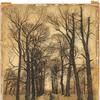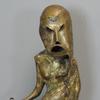Fred Eversley: Black, White, Gray opens at Rose Art Museum
- WALTHAM, Massachusetts
- /
- February 20, 2017
The Rose Art Museum at Brandeis University presents Fred Eversley: Black, White, Gray from February 17 through June 11, 2017. For more than four decades, Fred Eversley (b. 1941) has produced innovative and visually stunning sculptures that consider materials, light, and the optical qualities of shapes and colors as part of a broad investigation of individual perceptual experience. This exhibition examines for the first time a series of black, white, and gray cast-resin sculptures that Eversley began in the early 1970s, works that prompt us to consider the symbolic values of color and how we ascribe meaning to it. Curated by Rose Curator Kim Conaty, the exhibition is a collaboration between Art + Practice in Los Angeles and the Rose.
A Brooklyn native and engineer by training, Eversley moved to Los Angeles in 1963 to work in the aerospace industry; four years later, inspired by the burgeoning bohemian culture of Venice Beach, he decided to shift careers and become an artist. Since that time, Eversley has pushed the boundaries of sculpture, bringing his technical expertise and keen aesthetic sensibility to bear on the remarkable objects that he produces. In his groundbreaking experiments with plastic in the late 1960s, Eversley demonstrated how this modern, industrial material could be tinted with vibrant hues and cast into parabolic “lenses” using centrifugal force, creating the transparent, multi-colored sculptures for which he is best known today. This spirit of innovation permeates all of Eversley’s work, and his investigations into the optical qualities of shapes and colors are among his most compelling contributions.
Eversley’s embrace of synthetic materials, machined surfaces, and the luminosity of forms tie his work to the West Coast style of minimalism that emerged in the 1960s and came to be known as the Light and Space movement. He was a key figure in this movement, and his sculptural work was shown alongside that of other artists associated with this style, such as his friends and contemporaries Larry Bell and John McCracken.
At the Rose, Eversley will present an important series of monochrome sculptures in black, white, and gray. The series was initiated in 1972 when Eversley began to explore the qualities and beauty of the color black, a departure from the rich magenta, amber, and blue hues that distinguished his previous work. Experimenting with a can of black pigment given to him by John McCracken, who had used black in many of his signature “plank” sculptures beginning in the late 1960s, Eversley produced opaque and translucent sculptures of varying thickness, underscoring the tonal range that could be expressed through the refraction of light and curves of the form. Following the success of the initial black sculptures, Eversley expanded his investigation of this achromatic palette, experimenting with opaque white and gray tones.
Alongside a central grouping of parabolic lenses, the exhibition includes a small selection of cast, sliced cylinders along with examples of the artist’s wall arcs and stepped sculptures from the late 1970s, when he was working with pre-cast polyester resin in regular shapes that could be stacked and layered. The works have cosmological associations—“stars expanding their energy and becoming black holes, white dwarfs, and neutron stars,” Eversley explained at the time—but the lenses’ intimate human scale also prompt us to consider how color might relate to identity. As lenses through which we see and mirrors in which we are reflected, these works challenge us to think not only about what we see but also how we see it.
“Fred’s work reflects the vibrant moment of artistic and technological experimentation and exchange that characterized the West Coast art scene of the 1960s and early ‘70s—and the Light and Space movement in particular. We still have a lot to learn about these artists,” says Conaty. “There is a magical quality about Fred’s work that can only be experienced first-hand,” she added. “Viewers will have the rare opportunity to reflect on these works in time and space, as the artist intended: to move around them, get lost in the physics of their forms, and observe their kinetic properties as the natural illumination from the museum’s skylight changes throughout the day.”
ABOUT FRED EVERSLEY
Fred Eversley (b. 1941, Brooklyn) received his B.S. in Electrical Engineering from the Carnegie Institute of Technology (now, Carnegie Mellon University) in 1963. From that year through 1966, he worked at Wyle Laboratories in El Segundo, CA, where he supervised, among other major projects, the design and construction of high intensity acoustic test laboratories at NASA facilities. He began his artistic career in 1967.
The first solo exhibition of Eversley’s work was held at the Whitney Museum of American Art in 1970. His work has been featured in subsequent one-man museum shows at the Santa Barbara Museum of Art (1976), the Oakland Museum of California (1977), the Palm Springs Museum of Art (1978), and the National Academy of Science (1981), and in over two hundred solo and group exhibitions internationally, in venues such as the Museum of Contemporary Art, Chicago; the Jewish Museum, New York; the Indianapolis Museum of Art; the Los Angeles County Museum of Art; the Museum of Contemporary Art, Los Angeles, and the Museo Nacional Centro del Arte Reina Sofia, Madrid. It was also featured in several group exhibitions dedicated to the work of African American artists, including Contemporary Black Artists in America at the Whitney Museum of American Art in 1971, one year after his solo museum exhibition, Fred Eversley: Recent Sculpture, was held there. He was appointed the first Artist-in-Residence at the Smithsonian Institution’s National Air and Space Museum, Washington, D.C. (1977–80) where he worked in a large custom-built studio in the museum and resided in the Barney Studio House (now the Latvian Embassy). His work is in the permanent collections of some thirty museums, and he has executed over fifteen large-scale public art commissions. His largest public sculpture, the 35-foot-tall Parabolic Flight (1980), was recently refurbished and re-installed at the Miami-Dade International Airport. He has been selected to create the Entrance Plaza sculpture for the new District Square Center, at Crenshaw Boulevard and Rodeo Road, Los Angeles.
In March 2018, Eversley’s work will be the subject of a major survey exhibition Fred Eversley: Seeing Through Sculpture, at the Huntington Library, Art Collections, and Botanical Gardens. He lives and works in Venice, California and New York, New York.
ABOUT THE ROSE ART MUSEUM AT BRANDEIS UNIVERSITY
Founded in 1961, the Rose Art Museum at Brandeis University is among the nation’s premier university museums dedicated to collecting, preserving, exhibiting, and interpreting 20th and 21st century art. A center of cultural and intellectual life on campus, the Museum serves as a catalyst for artistic expression, a living textbook for object-based learning, and a site for scholarly innovation and the production of new knowledge through art. American painting of the post-war period and contemporary art are particularly well represented within the Rose’s permanent collection, which is now more than 8,000 objects strong.
Major paintings by Willem de Kooning, Jasper Johns, Roy Lichtenstein, Helen Frankenthaler, and Andy Warhol anchor the collection, and recently acquired works by Mark Bradford, Al Loving, Jack Whitten, and Charline von Heyl build upon this strength while reflecting the Museum’s commitment to works of both artistic importance and social relevance. Through its collection, exhibitions, and programs, the Rose works to affirm and advance the values of global diversity, freedom of expression, and social justice that are hallmarks of Brandeis University.
Located on Brandeis University’s campus at 415 South Street, Waltham, MA, the museum is free and open to the public Wednesday through Sunday, 11 AM – 5 PM. For more information, visit www.brandeis.edu/rose/ or call 781-736-3434.
ABOUT ART + PRACTICE
Conceived and founded by artist Mark Bradford, philanthropist and collector Eileen Harris Norton, and social activist Allan DiCastro, Art + Practice (A+P) is an arts and education private operating foundation based in Leimert Park, Los Angeles. A+P’s mandate is to create a developmental platform that, on one hand, supports the acquisition of practical skills for foster youth, and, on the other, stresses the importance of creative activity within a larger social context. For more information visit www.artandpractive.org.
PRESS CONTACTS
ROSE ART MUSEUM
Nina Berger, nberger@brandeis.edu, +1.617.543.1595
ART + PRACTICE
Natalie Hon, natalie@artandpractice.org, +1.323.337.6887
Contact:
BergerRose Art Museum
6175431595
nberger@brandeis.edu
415 South Street
Waltham, Massachusetts
rosemail@courier.brandeis.edu
781-736-3434
http://www.brandeis.edu/rose
About Rose Art Museum at Brandeis University
The Rose Art Museum at Brandeis is among the premier university museums of modern and contemporary art in the country. Through its distinguished collection of mid-20th through 21st-century art, cutting-edge exhibitions and dynamic programs, visitors can experience the art, artists and ideas of our time.







![Peter Paul Rubens (Flemish, 1577–1640), After Titian (Tiziano Vecelli) (Italian [Venetian], c. 1488–1576), Rape of Europa, 1628–29. Oil on canvas, 71 7/8 x 79 3/8 in. Peter Paul Rubens (Flemish, 1577–1640), After Titian (Tiziano Vecelli) (Italian [Venetian], c. 1488–1576), Rape of Europa, 1628–29. Oil on canvas, 71 7/8 x 79 3/8 in.](/images/c/e2/2e/Jan20_Rape_of_Europa100x100_c.jpg)





![Offering a Truce [Bested], 1895, is estimated to sell for between $1,300,000 and $1,800,000 on March 22, 2014, for The Russell: An Exhibition and Sale to Benefit the C.M. Russell Museum. Offering a Truce [Bested], 1895, is estimated to sell for between $1,300,000 and $1,800,000 on March 22, 2014, for The Russell: An Exhibition and Sale to Benefit the C.M. Russell Museum.](/images/c/a8/20/Dec10_Offering_a_Truce__Bested_300dpi100x100_c.jpg)
